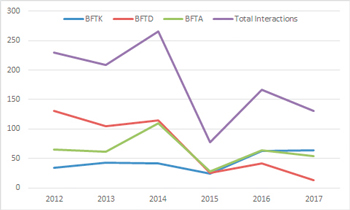Individual Bluefin Quota Program Document Released

2012–2017 interactions on observed trips. BFTK = Bluefin kept; BFTD = Bluefin discarded dead; BFTA = Bluefin discarded alive.
The complete document with full summary, related documents and data from the U.S. Department of Commerce | National Oceanic and Atmospheric Administration | National Marine Fisheries Service is available here.
Executive Summary Introduction
Atlantic bluefin tuna (bluefin) are highly migratory pelagic fish that range across most of the North Atlantic and its adjacent seas, including the Gulf of Mexico and Mediterranean Sea. The bluefin fishery is a quota-managed fishery, and the annual U.S. bluefin quota is established by binding recommendations of the International Commission for the Conservation of Atlantic Tunas (ICCAT). The U.S. bluefin quota established through that process is implemented domestically through rulemaking and allocated among seven quota categories, including the Longline category. The non-Longline quota categories include other commercial and recreational gear types and a Reserve category, used for research and inseason quota transfers as warranted. Most of these categories are for directed bluefin fisheries (commercial hand gear, purse seine, and recreational fisheries). The pelagic longline fishery is not authorized to directly fish for bluefin but catches them incidentally while targeting other species, primarily swordfish, yellowfin tuna, and bigeye tuna. The Longline quota category was established to provide the pelagic longline fishery with bluefin quota to account for that incidental catch. Landings and dead discards (i.e., catch) must be accounted for within the available U.S. quota.
Given certain challenges in the management of bluefin tuna, Amendment 7 to the 2006 Consolidated Highly Migratory Species Fishery Management Plan (Amendment 7) revised the conservation and management measures for the stock, including addressing issues regarding bycatch in the pelagic longline fishery. In that Amendment, a catch share program called the Individual Bluefin Quota (IBQ) Program was designed to introduce individual accountability to permitted pelagic longline vessels for bluefin bycatch and incentivize those participating in the pelagic longline fishery to minimize interactions with bluefin as a conservation and management measure for the stock. The IBQ Program and Electronic Monitoring (EM) Program were implemented in the pelagic longline fishery in the Atlantic Ocean (Atlantic) and Gulf of Mexico in 2015 through Amendment 7. The EM Program was implemented to support the IBQ Program by providing a means of verifying vessel-reported data on bluefin catch. Verification of vessel-reported data is important because of the increased individual accountability and potential incentives for vessel operators to misreport.
This review of the IBQ Program was conducted to evaluate its effectiveness in meeting the goals and objectives as specified in Amendment 7. “Catch shares” is a general term used for quota-based management strategies, including Limited Access Privilege Programs (LAPPs) and individual fishing quotas that allocate a specific percentage of the total allowable fishery catch or a specific fishing area to individuals, cooperatives, communities, or other entities. “Formal and detailed” reviews of all LAPPs established after January 12, 2007, such as the IBQ Program, are required to be conducted periodically by the regional Fishery Management Councils and Secretary of Commerce (Secretary) under the Magnuson-Stevens Fishery Conservation and Management Act (Magnuson-Stevens Act)(Section 303(c)(1)(G)). The contents of the review are based on guidance developed by the National Marine Fisheries Service (NMFS) (NMFS Procedural Instruction 01-121-01; Catch Share Policy; Guidance for Conducting Review of Catch Share Programs)(Catch Share Review Guidance). The guidance specifies that the review include the evaluation of whether or not the catch share program objectives were met, as well as evaluation of the various components of the catch share program.
